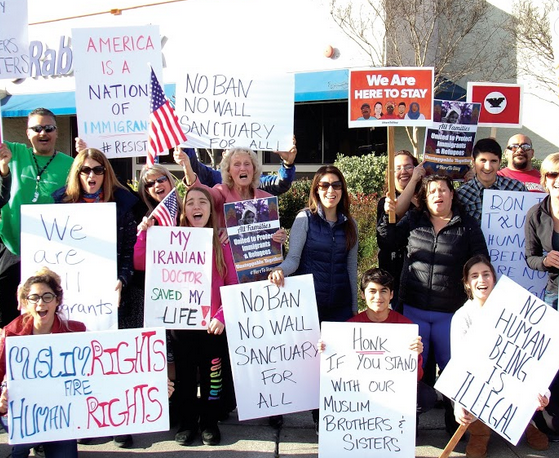As protests sprung up in airports across the nation last weekend in response to President Donald Trump’s latest executive action targeting refugees and immigrants from seven majority Muslim countries, a group of about 30 Gilroyans took to the street on Sunday to show their solidarity.
Standing at the corner of First Street and Wren, Gilroy residents—students, parents, teachers, and retirees—shouted anti-Trump slogans and waved signs that read “No Ban, No Wall, Sanctuary for All,” “My Iranian Doctor Saved My Life” and “America is a nation of immigrants,” among others.
“Diverse populations have created what we have in Gilroy—a beautiful community with a spice for life,” said Rebeca Armendariz, who was at Sunday’s protest. “To maintain that we need to actively and aggressively stand up to these measures by President Trump. We are an accepting and appreciative society.”
Signed into law by President Trump last Friday, the sweeping regulations temporarily halt refugees from coming into the U.S., indefinitely bar those from Syria, and prohibit the entry of citizens from Sudan, Yemen, Syria, Iraq, Iran, Libya, and Somalia from entering the U.S. for 90 days. Citizens in major cities including San Francisco, New York, Portland and Los Angeles reacted with spontaneous protests at airports.
While thousands of protesters demonstrated against the new rules, attorneys offered free legal advice to travelers caught in the dragnet. Before the administration issued a clarification on Sunday, green card holders from those select countries were detained at airports and kept from boarding a plane back to their legal residence in the U.S.
“The groundswell of protests across the country sends a strong message to the administration and the president that the executive actions run counter to the values we have in this country,” said Priya Murthy, policy and advocacy director at SIREN (Services, Immigrant Rights and Education Networks), a nonprofit that provides resources to immigrants in Santa Clara County and advocates for immigrant rights. “Throughout our nation’s history we have taken great pride in welcoming those who are fleeing persecution and seeking safety.”
Bill James, Chair of the Santa Clara Democratic Party, which will hold a day of action on March 11 to fire up the base and strategize opposition to the new Republican majority on Capitol Hill, said the images of Americans protesting President Trump’s policies send a message to the world and to political leaders in this country.
“Protesting in large numbers gives strength and support to our Democratic legislators and governor to stand up to President Trump, and should give even Republican elected officials pause,” says James.
Georgine Scott-Codiga, Gilroy resident and president of the Morgan Hill/Gilroy Patriots group, a Tea Party offshoot, does not see it that way. She said the new president was well within his right to review the country’s national security policies and was quite shocked over the uproar.
“President Obama placed a six-month hold on those countries and you didn’t hear one little peep,” she said. “These are people who are still not accepting the fact that Trump won.”
In California, where almost 11 million residents—nearly 27 percent of the population—is foreign-born, the topic of immigration has been taken up at school boards, city councils and county seats across the state, as anxiety has heightened among immigrants and their allies.
The state senate is currently debating SB54, the California Values Act, which would prevent the use of state and local public resources to aid federal Immigration and Customs Enforcement (ICE) agents in deportation actions, effectively turning California into one big Sanctuary State.
Introduced last month by California Senate President pro Tempore Kevin de León (D-Los Angeles), the law would put the state on a collision course with the combative new president who last week signed an executive order threatening the loss of federal funds to so-called Sanctuary Cities.
“It is currently unknown what the federal impact could be—which type of funding could be at risk if the administration decides to go after these type of cities,” said Murthy. “We’ve heard from elected leadership at the county level that they are willing to fight this in the courts if necessary.”
At the next Gilroy City Council meeting on Monday, Feb. 6, council representatives will discuss a proclamation providing support and assurance to the city’s residents, similar to what the City of Morgan Hill did earlier this month.
Murthy said the proclamation is an important start, but it should be followed up with robust safety policies that create a shield of protection for the local immigrant community.
“They need to go beyond making statements and institute policies that state they won’t assist federal immigration and customs enforcement agents or require law enforcement to enquire about immigration status,” she said.
Gilroy resident Alicia Juarez agrees. A community leader with PACT (People Acting in Community Together), a multi-faith action group that has held workshops on immigration and citizenship in Gilroy, said they want greater policy protections from Gilroy and the City of Morgan Hill, where a new ICE office has relocated from San Jose.
According to a report earlier this month by the Morgan Hill Times, ICE officials said that the office, located near the police station, will not be a detention facility but that “federal authorities can temporarily hold subjects accused of violating immigration laws at the site,” and an application to put in “temporary holding rooms” has been submitted to the city’s planning department.
“We are looking for something stronger than a letter, which is just symbolic,” said Juarez. “We are asking the cities to have no cooperation with ICE. People need to feel safe in Gilroy and know that the police will protect and support them too.”
The Gilroy City Council agenda and packet for Monday, Feb. 6 meeting is here: http://www.cityofgilroy.org/AgendaCenter/ViewFile/Agenda/02062017-1270?html=true















